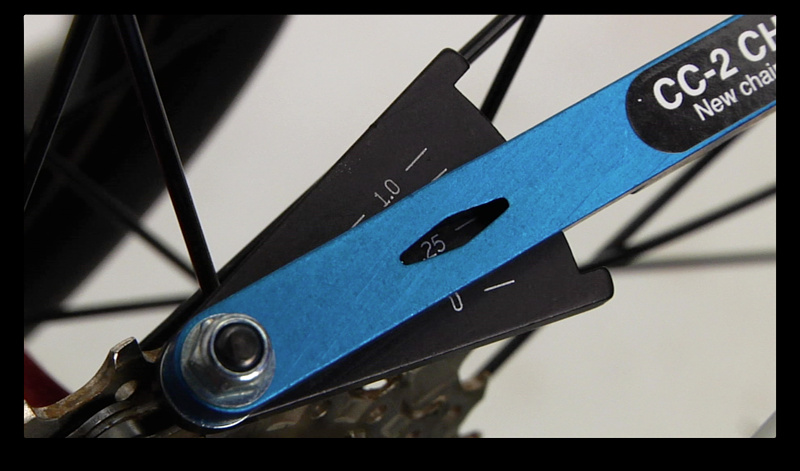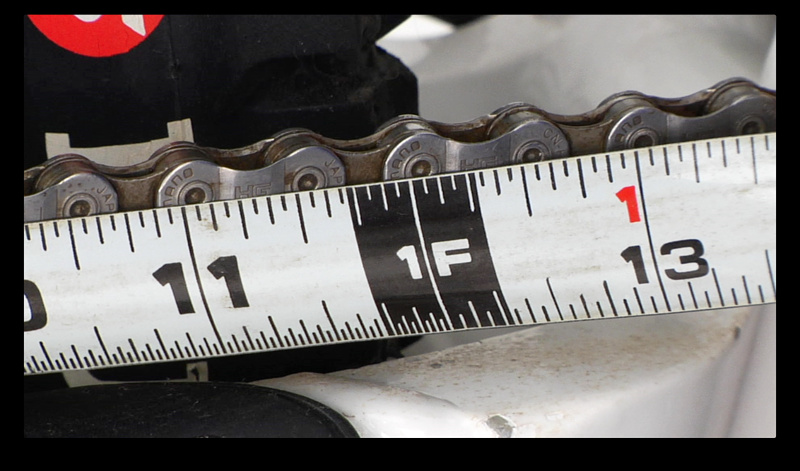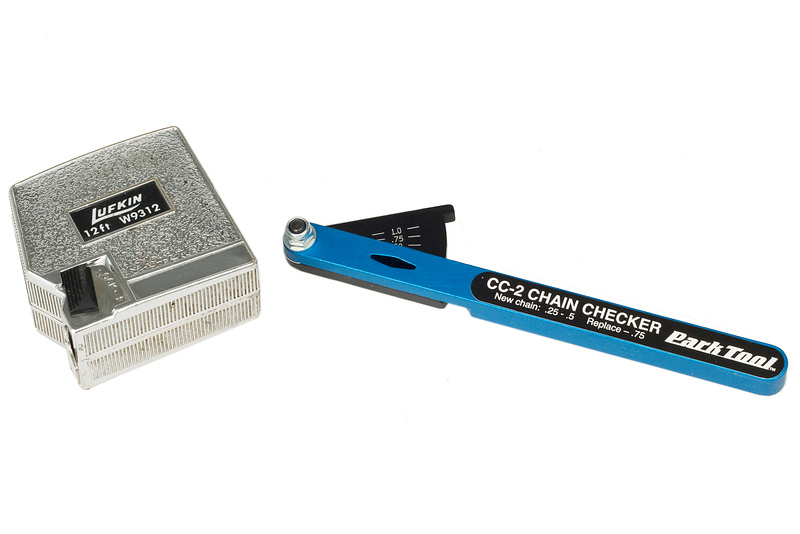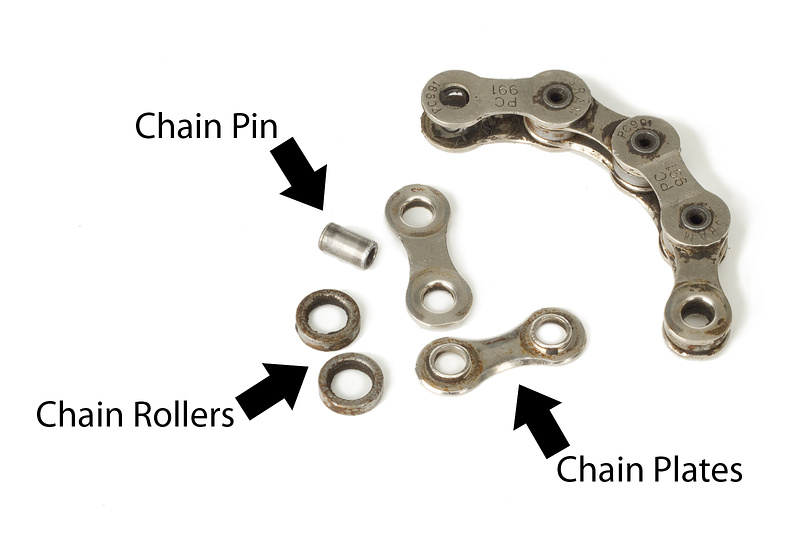Technical Tuesday: Chain Wear
For today's Technical Tuesday we're going to have a closer look at chain wear. We'll explain what exactly is happening to your drivetrain as it wears, as well as how to properly check your chain to see if it's time to replace it. Inside you'll find a video full of information and step by step instructions on how to find out just how worn out your poor chain actually is!
Read on...One thing that all of our bikes have in common despite their intended discipline, amount of travel, or wheel size, is that they're all powered by a bicycle chain. And from what I've seen, there is a pretty good chance that your chain is either already worn out or is very close to being so. Reading comments from past Technical Tuesdays it is pretty clear that everyone wants to learn how to rebuild their suspension or lace up a wheel, and we will be covering those jobs down the road, but we still have some relatively basic tasks to cover first. It's incredible how many very expensive bikes I've seen that have the latest and greatest parts on them, but have drivetrains that are completely worn out. This is unacceptable in my books! For this Technical Tuesday we are going to show you how to not only properly check for chain wear and some of it's symptoms, but we'll also explain exactly what is happening to your drivetrain as it becomes more and more worn. Watch the video below and then have a look at a past Technical Tuesday that shows you how to properly use a chain tool and replace that poor worn out chain of yours!
Watch the video to learn about chain wear and how to check for it:
Step by step instructions on checking for chain wear
Tools needed: Chain checker or tape measure.
A modern bicycle chain is made up of inner plates, outer plates, pins, and finally the rollers. The pins are pressed through the outer plates and the rollers and inner plates are free to rotate on them. This allows the chain to circle freely around the chainrings, cogs, and pulley wheels. Two things are happening to your chain as it begins to wear. The most obvious symptom is known as "chain stretch", but the name is a bit misleading. It would be easy to be mistaken in thinking that the inner and outer plates actually stretch with use, but that isn't the case. What is actually happening is the tolerances of the press fit between the chain pins and outer plates is increasing over time and as the small gaps get bigger, the distance between the chain pins get bigger and the total length of the chain increases. The other symptom of a worn chain is rollers that both seem to have shrunk in size, as well as have a lot more room to "float" in the space between the two inner plates. As a chain is used, the rollers slowly get worn down from contact with the cogs and chainrings. As they get smaller, the gap between them obviously increases in size. Further exasperating this issue is how the roller has room to rattle or float within the inner plates. This is caused by wearing down of the inner shoulder that the rollers turn on. So the question is then, how does a worn chain effect the rest of your drivetrain?
A new bicycle chain has a pitch of 1/2" (pitch is the measurement from one chain pin to the next) that matches the same pitch on our chainrings and cogs. The pitch of a chain gets longer as a chain wears. The chain rollers that apply torque to the same spot on each gear tooth as you pedal will slowly wear the teeth as well, although at a slower rate than the chain itself wears. The teeth on the cog or chainring are shaped to work perfectly with the size of the rollers on a half inch chain, as well as being just the right distance apart from their neighbor. Material is slowly removed from the leading edge of the gear teeth as a worn chain applies torque to them, and the ever important distance between each tooth actually gets larger as this happens. This is most evident when you install a new chain on a worn out cassette and discover that it skips under load. Simply put, the new chain will not fit the worn cassette due to the gaps between the teeth now being too large for the new chain and it's 1/2" pitch. There isn't enough engagement to keep it from skipping as you pedal hard. Because a chain wears faster than a cassette, it makes sense to replace your chain multiple times before they become too worn, thereby making your cassette last much longer. The teeth on a worn cassette will have a much more pronounced point to them and look very much like a shark's fin. Chainrings generally wear much slower due to much more contact with the chain which distributes the load over a greater area. Even when a large chainring is badly worn, it may not skip simply due to the amount of wrap that the chain has around it. Middle and small chainrings are another story though...
Measuring a chain with Park's CC-2 chain checker
![photo]()
![photo]()
Measuring a chain with a tape measure
![photo]()
Don't fret if you don't have a specific chain measuring tool, you can also use a standard tape measure or ruler to figure it out. Just like using a chain checker, you can do this while the chain is still on the bike.
• Line up the tape measure so that the zero inch mark is directly in line with one of the chain pins.
• Holding the tape measure in line with the chain, measure out exactly 6 complete links (A link is a set of both inner and outer plates).
• Because the pitch (distance between each link) of the chain is 1/2", 6 complete links on a new chain will measure exactly out to 12".
• If the chain has wear, the pin will line up slightly past the 12" mark on the tape measure. A general rule of thumb is to replace the
chain once it is over 1/16" past the 12" mark.
Past Tech Tuesdays:
Technical Tuesday #1 - How to change a tube.
Technical Tuesday #2 - How to set up your SRAM rear derailleur
Technical Tuesday #3 - How to remove and install pedals
Technical Tuesday #4 - How To Bleed Your Avid Elixir Brakes
Technical Tuesday #5 - How To Check And Adjust Your Headset
Technical Tuesday #6 - How To Fix A Broken Chain
Technical Tuesday #7 - Tubeless Conversion
Have you found this tutorial helpful? Share any of your hints or tips below!
Visit Parktool.com to see their entire lineup of tools.
Read on...One thing that all of our bikes have in common despite their intended discipline, amount of travel, or wheel size, is that they're all powered by a bicycle chain. And from what I've seen, there is a pretty good chance that your chain is either already worn out or is very close to being so. Reading comments from past Technical Tuesdays it is pretty clear that everyone wants to learn how to rebuild their suspension or lace up a wheel, and we will be covering those jobs down the road, but we still have some relatively basic tasks to cover first. It's incredible how many very expensive bikes I've seen that have the latest and greatest parts on them, but have drivetrains that are completely worn out. This is unacceptable in my books! For this Technical Tuesday we are going to show you how to not only properly check for chain wear and some of it's symptoms, but we'll also explain exactly what is happening to your drivetrain as it becomes more and more worn. Watch the video below and then have a look at a past Technical Tuesday that shows you how to properly use a chain tool and replace that poor worn out chain of yours!
Tools needed: Chain checker or tape measure.
A modern bicycle chain is made up of inner plates, outer plates, pins, and finally the rollers. The pins are pressed through the outer plates and the rollers and inner plates are free to rotate on them. This allows the chain to circle freely around the chainrings, cogs, and pulley wheels. Two things are happening to your chain as it begins to wear. The most obvious symptom is known as "chain stretch", but the name is a bit misleading. It would be easy to be mistaken in thinking that the inner and outer plates actually stretch with use, but that isn't the case. What is actually happening is the tolerances of the press fit between the chain pins and outer plates is increasing over time and as the small gaps get bigger, the distance between the chain pins get bigger and the total length of the chain increases. The other symptom of a worn chain is rollers that both seem to have shrunk in size, as well as have a lot more room to "float" in the space between the two inner plates. As a chain is used, the rollers slowly get worn down from contact with the cogs and chainrings. As they get smaller, the gap between them obviously increases in size. Further exasperating this issue is how the roller has room to rattle or float within the inner plates. This is caused by wearing down of the inner shoulder that the rollers turn on. So the question is then, how does a worn chain effect the rest of your drivetrain?
A new bicycle chain has a pitch of 1/2" (pitch is the measurement from one chain pin to the next) that matches the same pitch on our chainrings and cogs. The pitch of a chain gets longer as a chain wears. The chain rollers that apply torque to the same spot on each gear tooth as you pedal will slowly wear the teeth as well, although at a slower rate than the chain itself wears. The teeth on the cog or chainring are shaped to work perfectly with the size of the rollers on a half inch chain, as well as being just the right distance apart from their neighbor. Material is slowly removed from the leading edge of the gear teeth as a worn chain applies torque to them, and the ever important distance between each tooth actually gets larger as this happens. This is most evident when you install a new chain on a worn out cassette and discover that it skips under load. Simply put, the new chain will not fit the worn cassette due to the gaps between the teeth now being too large for the new chain and it's 1/2" pitch. There isn't enough engagement to keep it from skipping as you pedal hard. Because a chain wears faster than a cassette, it makes sense to replace your chain multiple times before they become too worn, thereby making your cassette last much longer. The teeth on a worn cassette will have a much more pronounced point to them and look very much like a shark's fin. Chainrings generally wear much slower due to much more contact with the chain which distributes the load over a greater area. Even when a large chainring is badly worn, it may not skip simply due to the amount of wrap that the chain has around it. Middle and small chainrings are another story though...

Step 1. Turn the gauge on the CC-2 tool to zero and place both pins into the gap between the rollers

Step 2. The gauge on the CC-2 tool tells you just how worn the chain is. Replace if it's at .75 or higher

Step 2. Six complete links on a chain in good shape will measure in at 12". Any more that 1/16" needs replacing
Don't fret if you don't have a specific chain measuring tool, you can also use a standard tape measure or ruler to figure it out. Just like using a chain checker, you can do this while the chain is still on the bike.
• Line up the tape measure so that the zero inch mark is directly in line with one of the chain pins.
• Holding the tape measure in line with the chain, measure out exactly 6 complete links (A link is a set of both inner and outer plates).
• Because the pitch (distance between each link) of the chain is 1/2", 6 complete links on a new chain will measure exactly out to 12".
• If the chain has wear, the pin will line up slightly past the 12" mark on the tape measure. A general rule of thumb is to replace the
chain once it is over 1/16" past the 12" mark.
Past Tech Tuesdays:
Technical Tuesday #1 - How to change a tube.
Technical Tuesday #2 - How to set up your SRAM rear derailleur
Technical Tuesday #3 - How to remove and install pedals
Technical Tuesday #4 - How To Bleed Your Avid Elixir Brakes
Technical Tuesday #5 - How To Check And Adjust Your Headset
Technical Tuesday #6 - How To Fix A Broken Chain
Technical Tuesday #7 - Tubeless Conversion
Have you found this tutorial helpful? Share any of your hints or tips below!
Visit Parktool.com to see their entire lineup of tools.
Author Info:
Must Read This Week
Sign Up for the Pinkbike Newsletter - All the Biggest, Most Interesting Stories in your Inbox
PB Newsletter Signup






Another rough-and-ready way to check chain wear is to put the chain on the biggest chain ring and see if you can pull the middle of it away from the ring - takes some time to figure out how far means worn out, but it's quick.
Also, you should check out the late venerable Sheldon Brown's article on this: sheldonbrown.com/chains.html . He was the man.
I add not to use degreaser ever on your chain - just run it through a rag, brush it, and lube it - that's how I get the best mileage - sorry skippy888, I mean kilometerage
Do you mean not even the Park Tool stuff? I use that on a regular basis with Cyclone chain cleaning tool. And now I have Pedro's creamy lookin stuff that you put right on and scrub which seems to work real nice.
If I clean a chain after every ride in degreaser until it is shiny I will get 1000miles out of it. If I never touch a chain with degreaser and only run it through a rag and lube it I will get 6-8 thousand miles out of it. Obvioulsy this is the opposite of the expected outcome.
Shimano also worked out that if you flip your chain over regularly you will also get another 15% life out of it - but they never worked out why. I saw that in a magazine a million years ago and have never heard or seen it again - probably because Shimanos chain sales went down 15%!
It's not rocket science!
but have to complain about one sentence: "...chain stretch. this isnt actually descripting what is happening...."
iam sorry but it IS chain stretch. that is what is happening with the chain! INCLUDING the pin-gaps get stretched too.
this and every other metal, will be stretched when its strained. also if the strain is far below the yield strengh. after 100... or more cyclic deformation you will be able to measure a elongation also from the plates.
This is the worst problem for weight weenies. £60 chains and £120+ cassettes. For something that needs frequent replacement. At least I made the decision to stop pedalling up hills, saves my drivetrain and wallet that much more!
@NorCalNomad cheers for that
@infamous, i get 1/2'' for each link makes 24'' for 12 links :s
its actually the text below the picture is wrong,
its 6'' for 12 links (so from above go from 1'' to 7'', this way you wont have an error (minimises the chances of it being wrong even if your tape measure is good from 0, like mine.))
Thanks for this info. Though sorta basic, I always forget the exact numbers.
No probs for me as I know what he's talking about. No beef seriously.
How about 10 links = 254mm, replace at 256 (which is 0.79% wear).
Your having to spend loads on new chains
Thank god for single speed.
How can you tell when your cassette/chainrings/jockey wheels have worn enough that they need to be replaced? It has to do with the teeth getting rounded, but a clear presentation of exactly what to look for would be nice.